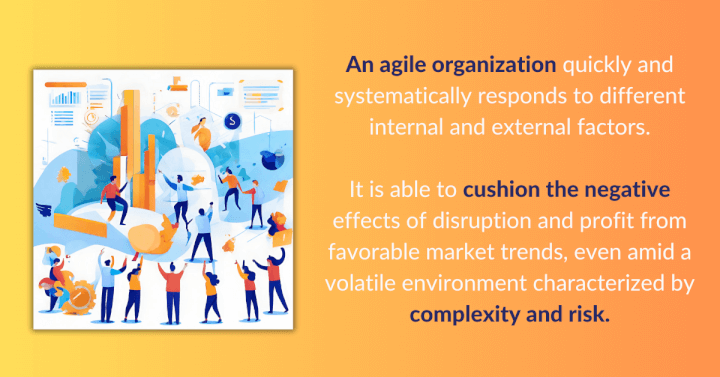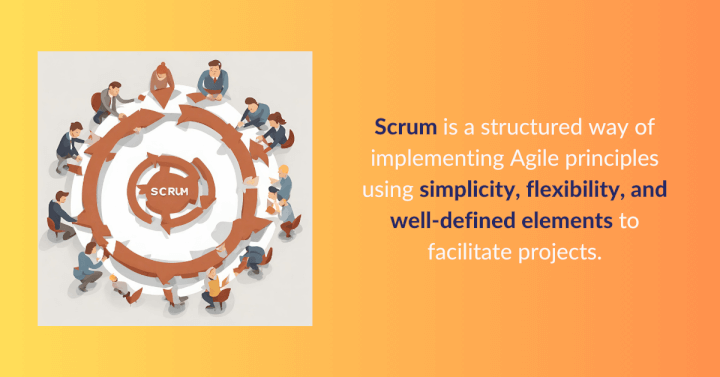Businesses need to manage risks, opportunities, and change. The better they do so, the more likely they are to succeed. How? Seizing the right opportunity can take your team to the big league. Ignoring the wrong risks can cause your company to close shop. Unwillingness to adapt as customer behavior and market realities shift erodes your relevance and competitive advantage. These facts explain why business agility has become a paramount indicator of organizational success and why the agile mindset and scrum methodology have seen spiking adoption rates over the years.
What is business agility?
Business agility refers to the organizational trait that enables companies to quickly and systematically respond to different internal and external factors. It helps organizations cushion the negative effects of disruption, profit from favorable market trends, and innovate in a cost-efficient manner. Achieved by optimizing human talent, process, and technology, business agility enables organizations to thrive even amid a volatile environment characterized by complexity and risk.
Agile organizations are adaptable, flexible, and proactively aware of key business drivers such as customer behavior and emerging technologies. These companies willingly “fail fast” in order to succeed. They do so by accelerating product development and testing in a fail-safe environment to find the winning recipe well before less agile competitors do.
Major disruptions such as the recent pandemic and the rise of generative AI like Midjourney and ChatGPT demonstrate the critical importance of business agility. For example, companies that have successfully implemented remote work and/or transitioned their supply-side and customer-facing operations to the cloud have endured the near-existential impact of pandemic restrictions. Some of these proactive companies have even seen significant upticks in business performance. In fact, McKinsey reported that the digital transformation of customer and supply-chain interactions in surveyed organizations had been fast-tracked during the pandemic by as much as four years.

Meanwhile, the National Bureau of Economic Research found that generative AI can increase workforce productivity by an average of 14%. Early adopters of this technology can expect to reap compounded benefits over time, with the rest eventually joining the bandwagon to grab their share of residual gains. The ability of generative AI to boost worker performance while lowering costs is expected to grow the generative AI market to around US$207 billion by 2030, according to Statista. Agile companies that can quickly leverage these next-generation tools to enhance sales operations, customer service, product design, marketing campaigns, and other aspects of their business can potentially improve both their top and bottom line figures much sooner than their peers.
Among the first in its class to embrace generative AI, GoSkills introduced their content assistant Genie in May 2023 to help individuals and businesses refine and accelerate their course authoring efforts.
These examples highlight the advantage of agile companies over organizations whose traditional practices have become more entrenched and rigid over time, significantly limiting their ability to respond dynamically to change.
But how does an organization become agile?
For the most part, doing so requires a cultural shift that starts with changing how an organization thinks about projects, processes, and people.
Agile mindset and culture
Agile is an attitude, not a technique with boundaries.
– Alistair Cockburn, Agile Movement Pioneer
Agile is a set of project management principles that prescribes adaptability and rapid iteration to leverage change and address business challenges. Unlike conventional methods (which are primarily sequential, linear, and rigid), Agile is flexible, collaborative, and iterative.
Teams in an Agile environment are cross-functional, autonomous, and tightly integrated through collaboration. Individual team members may not necessarily perform clear-cut roles but often have robust skill sets to handle various tasks. Team members work closely with each other and with other teams and stakeholders.
To enable iterative progression, Agile teams break down projects into small increments that are developed, tested, and iterated in a timebox (a set amount of time during which work must be completed). Timeboxes help enhance collaboration, manage risk, and quickly demonstrate results to stakeholders.
Benefits
Agile's resounding adoption and success rates over many years attest to its compelling benefits. A comprehensive study by Digital.ai found that nearly 90% of custom software development teams already implement Agile, while a separate 2023 report found that more than 40% of marketers plan to implement the approach in the near term.
Companies invest heavily in Agile because its practices and methods enable them to:
- Accelerate collaborative processes (such as software development) and time to market
- Improve business agility (i.e., mitigate risk, manage change)
- Enhance team collaboration and productivity
- Innovate cost-efficiently
- Develop individual member skill sets
- Establish a high-performing culture
- Improve financial performance
Agile practices benefit individuals, teams, and organizations, helping drive fundamental transformation across the board:
- Because Agile adopts an iterative and collaborative approach, individual members develop a sense of ownership over their work, improve their communication and problem-solving skills, and feel motivated to seek continuous self-improvement. Empowered individuals with high employee satisfaction levels are less likely to leave the company.
- Because Agile breaks down projects into small, time-boxed increments, teams can achieve shorter value delivery cycles and quicker times-to-market. Early user feedback allows for higher product quality and customer satisfaction over time. The relative ease of completing broken-down tasks also allows for early wins and relieves stress among individuals and teams.
- Because Agile embraces change and implements a customer-centric paradigm, organizations are better able to manage market fluctuations, technological disruptions, and unforeseen challenges. By emphasizing feedback loops and rapid iterations, Agile helps improve process efficiencies and resource optimization.
- Taken together, the behavioral changes Agile initiates in individuals, teams, and the whole organization lead to a culture of openness, continuous learning, innovation, and growth.
Applicability
Primarily applied in software development, Agile can be adopted for other types of projects, initiatives, or business operations such as HR, R&D, and marketing. However, keep in mind that there are project types for which other methods may be more effective than Agile. In general, Agile works best for projects with shorter schedules for completion, are susceptible to multiple changes as they progress, and require cross-team collaboration (as opposed to a strict, top-down approach). Projects with unclear or flexible constraints (budgets, timelines, and available resources) are also good candidates for an Agile management approach.
Note that merely having well-suited projects for Agile does not necessitate its immediate adoption. You still have to determine your company’s readiness (e.g., leadership buy-in, resistance to change, industry, staff skills, etc.) for the approach. This is important because studies indicate that company culture and lack of management support are the leading causes of unsuccessful Agile implementations.
Agile works best for projects with shorter schedules for completion, are susceptible to multiple changes as they progress, and require cross-team collaboration.
If you are considering adopting Agile as your organization's default framework, here are seven questions that will help you determine if Agile is the best fit for your company.
Implementing Agile through Scrum methodology
Agile is a broad term that covers many practices, methodologies, and frameworks. Based on the adoption rate, the most popular of these frameworks are Scrum (87%), Kanban (56%), ScrumBan (27%), and Iterative (20%).
Implementing Agile principles through Scrum practices has long been a favored tactic for building business agility and for transforming legacy groupthink into a next-gen corporate culture.
If this is your initial foray into Agile, you may well start by learning the fundamental concepts in Scrum.
What is Scrum?
Scrum is a structured way of implementing Agile principles using simplicity, flexibility, and well-defined elements to facilitate projects. These elements include roles, artifacts, and events.
Roles
- Scrum Team – A self-organizing group of developers, designers, content creators, testers, and other stakeholders who work collaboratively to deliver sprint goals.
- Scrum Member – An individual (traditionally a developer) on the Scrum team who performs sprint-related tasks.
- Scrum Master – The person who facilitates Scrum events.
- Product Owner – The person responsible for articulating the product vision, ensuring everyone understands the direction and long-term goals of the product.
Artifacts
- Product – The outcome created by the Scrum team. It can be a physical product, software application, service, or any other value that users can offer.
- Increment – The working and potentially releasable product that is created from each completed sprint.
- Product Backlog – The prioritized list of product features and their requisite tasks that serve as the scrum team’s roadmap.
- Sprint Backlog – The list of tasks that need to be delivered during a specific sprint. Inherently dynamic, this list can be updated throughout the sprint as required.
Events
- Sprint – A short, focused cycle of around two to four weeks within which the team works on completing tasks and achieving goals as specified in the Spring Backlog.
- Daily Scrum – A short daily stand-up meeting of around 15 minutes that helps keep everyone aligned with the sprint goals.
- Sprint Planning – The collaborative process where the team plans and specifies the work to be completed for the upcoming sprint.
- Sprint Review and Retrospective – Conducted at the end of each sprint, this event allows the team to showcase their work to stakeholders and identify areas for improvement and growth.

Scrum’s structured approach to Agile encourages autonomous decision-making, frequent and open communication, self-organization, and flexibility.
Become an Agile and Scrum expert
Scrum is simple and flexible enough to be adopted by any company. However, to fully optimize its features and advantages, individuals and teams can take bite-sized courses to improve their scrum processes and results further.
The following tips can help your company elevate its business agility to the next level.
Final takeaway
Scrum might be a light and easy method for making your business more agile. But in many proven cases, it can punch way above its weight. When your company uses the simple practices of scrum to actualize the aspirational principles of agile, you help build a dynamic culture of innovation and high performance.
By instituting close collaboration, rapid iteration, and continuous improvement, agile and scrum help ensure that your brand stays relevant to your target customers and that your company adapts well to any change in the landscape. However, only a thorough understanding of Agile and Scrum would enable your company to fully realize their transformative benefits.
This year could be the best time to try something new for your business. Who knows, establishing an agile culture might just be the one step you need to break through!
Get the GoSkills Courses plan for your team
Give your team access to world-class project management training.
Learn more



